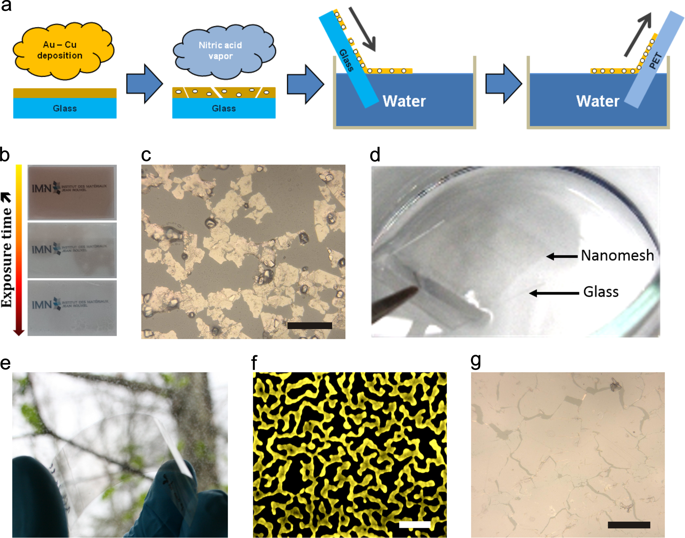npj Flexible Electronics ( IF 12.3 ) Pub Date : 2019-03-07 , DOI: 10.1038/s41528-019-0049-1 Adrien Chauvin , Willigis Txia Cha Heu , Joze Buh , Pierre-Yves Tessier , Abdel-Aziz El Mel

|
The booming market of flexible electronic displays has urged the development of highly flexible transparent conductive electrodes (FTCE)1,2,3 with the ability to replace indium tin oxide (ITO) thin films routinely used as transparent conductive electrodes in photoelectronic devices. The high cost of indium and the poor mechanical stability of ITO under deformation are the main driving forces behind the development of this research area.4 The use of metal nanomeshes as FTCE is a promising concept with a real potential to substitute ITO in photoelectronic devices.5,6 However, the development of a low-cost fabrication approach allowing producing metal nanomesh electrodes with competitive prices and a high performance remains a real bottleneck for the photoelectronic industry. In this paper, we report on a robust approach very easy to implement allowing producing highly flexible metal nanomesh electrodes with high performance at a very low cost. This approach lies on a concept consisting in applying dealloying process to ultra-thin Au-Cu alloy thin films using acidic vapors instead of a liquid phase as routinely done in the literature. Using an appropriate procedure, the nanomeshes can be transferred to any planar or curved support where they can serve as a FTCE. As a proof of concept, we demonstrate that using this approach, one can easily fabricate gold nanomesh electrodes transferred onto polyethylene terephthalate (PET) film surface with 79% of transmittance and a sheet resistance as low as 44 Ω □−1 while maintaining exceptional stability under severe mechanical deformations.
中文翻译:

超薄膜的蒸汽脱合金:制造高柔性透明导电金属纳米网电极的有前途的概念
蓬勃发展的柔性电子显示器市场已敦促开发具有高柔性的透明导电电极(FTCE)1,2,3,以取代通常用作光电设备中的透明导电电极的氧化铟锡(ITO)薄膜。铟的高成本和变形下ITO的较差的机械稳定性是该研究领域发展的主要驱动力。4使用金属纳米网作为FTCE是一个很有前途的概念,具有在光电子器件中替代ITO的真正潜力。5,6然而,允许制造具有竞争力的价格和高性能的金属纳米网电极的低成本制造方法的发展仍然是光电工业的真正瓶颈。在本文中,我们报告了一种非常易于实施的鲁棒方法,该方法可以以非常低的成本生产出具有高性能的高柔性金属纳米网状电极。该方法基于一个概念,该概念包括使用酸性蒸气而非文献中通常采用的液相将脱合金工艺应用于超薄Au-Cu合金薄膜。使用适当的程序,可以将纳米网转移到可以用作FTCE的任何平面或弯曲载体上。作为概念的证明,我们证明了使用这种方法,-1,同时在严重的机械变形下保持出色的稳定性。











































 京公网安备 11010802027423号
京公网安备 11010802027423号